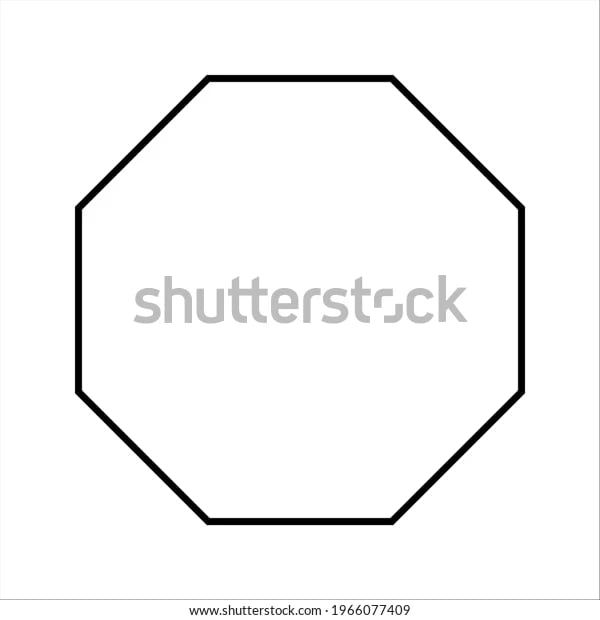How Many Diagonals are There in an Octagon
Introduction
A polygon with 8 sides and 8 angles is known as an "octagon" in geometry. That indicates that an octagon has 8 edges and vertices, respectively. The octagon is a two-dimensional, 8-sided polygon, also known as an 8-gon, in plain English. All of the sides of a regular octagon will be the same length. A regular octagon has interior angles that are each 135° in length.
As a result, the exterior angle is calculated as 180° - 135° = 45°.
An octagon's interior angles add up to 135\times8=1080^{\circ}. ![]()
Let's go into detail about the octagon shape, its formulas, characteristics, and examples in this article.
What is an Octagon?
A closed two-dimensional figure with eight sides, eight vertices, and eight interior angles is known as an octagon. An octagon is referred to as a regular octagon if all of its sides and interior angles are of equal length; otherwise, it is referred to as an irregular octagon. The following sections also explain the other octagon types, such as convex and concave octagons.
The Shape of an Octagon
In a two-dimensional plane, an octagon is a geometric shape. The octagon is a polygon, just like the other polygonal shapes that we have studied in geometry, such as the triangle, square, pentagon, hexagon, rectangle, etc. The fact that it has 8 sides and 8 angles distinguishes it from other geometrical shapes.
If an octagon is constructed with squares on all sides, either internally or externally, the midpoints of the sections joining the centres of the opposing squares form two types of quadrilaterals: Equi-diagonal and ortho-diagonal ( whose diagonals lengths are equal and they bisect each other at 90 degrees).
Examples of Octagons in Real Life
We may have noticed that various items we use daily have octagonal shapes. Examples include the following, among others:
Outline of an umbrella with 8 ribs
A wall clock with 8 edges
Stop the signboard at the signals
Earlier, an illustration helped you understand the shape of an octagon. Let's examine the sides of the octagon and how to depict them.
How Many Sides are There in an Octagon?
The octagon is an 8-sided polygon, as we already know. Therefore, an octagon has 8 sides. Additionally, there are two types of octagons: regular and irregular, depending on the length of these sides.
How Many Diagonals Does an Octagon Have?
An octagon contains a total of 20 diagonals.

Angles of an Octagon
The octagonal shape has eight angles at eight vertices, as previously defined. The octagon has 8 sides and 8 angles as a result. In an octagon, there are 8 interiors and 8 exterior angles. The sum of the interior angles of an octagon is 1080 degrees. Additionally, the total of the eight exterior angles is 360 degrees.
Properties of an Octagon
Typically, when discussing properties, regular octagons come to mind.
They have eight sides and eight angles.
Both the sides and the angles have equal lengths.
A regular octagon has a total of 20 diagonals.
The interior angles add up to a total of 1080°, with each angle being equal to 135°.
The octagon's exterior angles are all added up to 360 degrees, and each angle is 45 degrees.
Types of Octagon
The octagon is divided into the following groups depending on its sides and angles:
Regular and Irregular Octagon
Concave and Convex Octagon
Regular and Irregular Octagon
An octagon is referred to as being regular if all of its sides and angles are equal. However, it is referred to as an irregular octagon if its sides and angles aren't equal.
A regular octagon is a closed shape with equal-length sides and angles on the inside. It has an order of 8 rotational equilibrium and eight symmetrical lines. A regular octagon has a 135° interior angle at each of its vertices. The central angle is 45°.
Convex and Concave Octagon
An octagon is convex if all of its angles point outwards or if none of its angles points inwards. The convex octagon has angles that don't exceed 180°. And the octagon has a concave shape because one of its angles points inward.
Calculation and Formula
An octagon is a polygon with eight sides. To calculate the number of diagonals in an octagon, we can use the formula:
n(n-3)/2,
where n is the number of sides of the polygon.
For an octagon, n = 8, so we can substitute this value into the formula:
8(8-3)/2 = 20
Therefore, an octagon has 20 diagonals.
Conclusion
In conclusion, an octagon is a polygon with eight sides and eight angles. It is a fascinating shape with many applications in different fields, from architecture and design to mathematics and geometry. Octagons can be found in various objects, such as stop signs, Olympic medals, and even some buildings' floor plans.
One of the essential properties of octagons is that they can be divided into smaller shapes, such as triangles and rectangles, which makes them useful in tiling patterns. Moreover, octagons have symmetries that make them visually appealing and easy to work with.
Overall, the octagon is a unique and versatile shape that has been used in different contexts for centuries. Its properties and symmetry make it a fascinating topic of study, and its applications are far-reaching, making it an important shape to know and understand.
Applications for Admissions are open.
As per latest syllabus. Physics formulas, equations, & laws of class 11 & 12th chapters
JEE Main Important Chemistry formulas
Get nowAs per latest syllabus. Chemistry formulas, equations, & laws of class 11 & 12th chapters
JEE Main high scoring chapters and topics
Get nowAs per latest 2024 syllabus. Study 40% syllabus and score upto 100% marks in JEE
JEE Main Important Mathematics Formulas
Get nowAs per latest syllabus. Maths formulas, equations, & theorems of class 11 & 12th chapters